Dodge Journey: Line, A/C discharge
DESCRIPTION
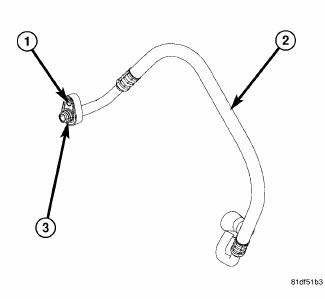
Fig. 241: Discharge Line Description
NOTE: 2.7L shown. Other engines similar.
The A/C discharge line (2) is the refrigerant line that carries refrigerant from the A/C compressor to the A/C condenser.
NOTE: Replacement of the refrigerant line O-ring seals and gaskets is required anytime a refrigerant line is disconnected. Failure to replace the rubber O-ring seals and metal gaskets could result in a refrigerant system leak.
The A/C discharge line has no serviceable parts except for the metal gaskets (1) and rubber O-ring seals (3) used on the fittings. The O-ring seals are made from a special type of rubber not affected by R-134a refrigerant.
The O-ring seals and gaskets must be replaced whenever the A/C discharge line is disconnected.
The A/C discharge line cannot be repaired and must be replaced if leaking or damaged.
REMOVAL
WARNING: Refer to the applicable warnings and cautions for this system before performing the following operation. Failure to follow the warnings and cautions may result in possible serious or fatal injury.
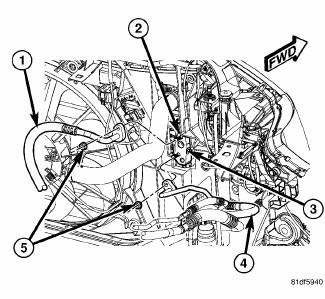
Fig. 242: Refrigerant Lines to Condenser Tapping Block
1. Disconnect and isolate the negative battery cable.
2. Recover the refrigerant from the refrigerant system.
3. Remove the nut (5) that secures the A/C discharge line (1) to the condenser tapping block (2) located on the right side of the condenser.
4. Disconnect the A/C discharge line from the tapping block.
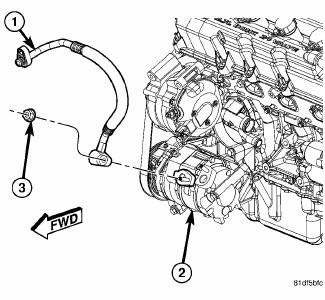
Fig. 243: Discharge Line to Compressor
NOTE: 2.7L shown. Other engines similar.
5. Remove the nut (3) that secures the A/C discharge line (1) to the A/C compressor (2).
6. Disconnect the A/C discharge line from the A/C compressor and remove the discharge line from the engine compartment.
7. Remove and discard the O-ring seals and gaskets and install plugs in, or tape over the opened discharge line fittings and the compressor and condenser ports.
INSTALLATION
CAUTION: Be certain to adjust the refrigerant oil level when servicing the A/C refrigerant system. Failure to properly adjust the refrigerant oil level will prevent the A/C system from operating as designed and can cause serious A/C compressor damage.
NOTE: When replacing multiple A/C system components, refer to the REFRIGERANT OIL CAPACITIES to determine how much oil should be added to the refrigerant system. NOTE: Replacement of the refrigerant line O-ring seals and gaskets is required anytime a refrigerant line is disconnected. Failure to replace the rubber O-ring seals and metal gaskets could result in a refrigerant system leak.
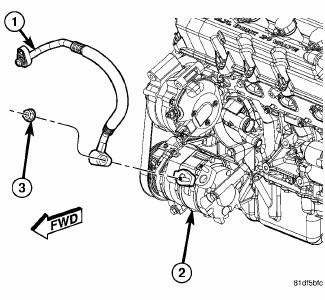
Fig. 244: Discharge Line to Compressor
NOTE: 2.7L shown. Other engines similar.
1. Remove the tape or plugs from the opened discharge line fittings and the compressor and condenser ports.
2. Lubricate new rubber O-ring seals with clean refrigerant oil and install them and new gaskets onto the discharge line fittings. Use only the specified O-rings as they are made of a special material for the R- 134a system. Use only refrigerant oil of the type recommended for the A/C compressor in the vehicle.
3. Position the A/C discharge line (1) into the engine compartment and connect it to the A/C compressor (2).
4. Install the nut (3) that secures the A/C discharge line to the A/C compressor. Tighten the nut to 20 N.m (15 ft. lbs.).
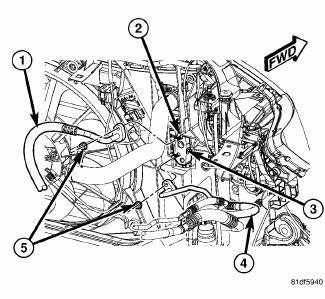
Fig. 245: Refrigerant Lines to Condenser Tapping Block
5. Connect the A/C discharge line (1) to the condenser tapping block (2).
6. Install the nut (5) that secures the A/C discharge line to the tapping block. Tighten the nut to 20 N.m (15 ft. lbs.).
7. Reconnect the negative battery cable.
CAUTION: Do NOT run the engine with a vacuum pump in operation or with a vacuum present within the A/C system when equipped with the Denso 6SEU16 variable displacement compressor. Failure to follow this caution will result in serious A/C compressor damage.
8. Evacuate the refrigerant system.
9. Adjust the refrigerant oil level.
10. Charge the refrigerant system.
 Removal, Installation
Removal, Installation
REMOVAL
WARNING: Refer to the applicable warnings and cautions for this
system before
performing the following operation. Failure to follow the warnings and
cautions may result in po ...
 Line, A/C liquid
Line, A/C liquid
...
See also:
Description, Diagnosis and Testing
Description
Fig. 17: PEDAL AND BOOSTER MOUNTING - LHD
The power brake booster (3) is mounted to the engine side of the dash panel.
The master cylinder is bolted to
the front of the booster. A v ...
Switch, backup lamp
REMOVAL
Fig. 249: Back-Up Lamp Switch
1. Disconnect battery negative cable.
2. Raise vehicle on hoist.
3. Disconnect backup lamp switch connector.
4. Remove backup lamp switch (1).
INSTA ...
Diagnosis and Testing
A/C EXPANSION VALVE
WARNING: Refer to the applicable warnings and cautions for this
system before
performing the following operation. Failure to follow the warnings and
cautions may ...
